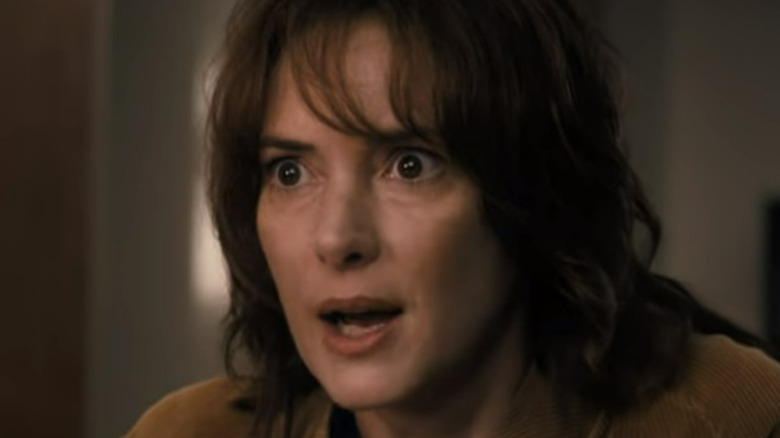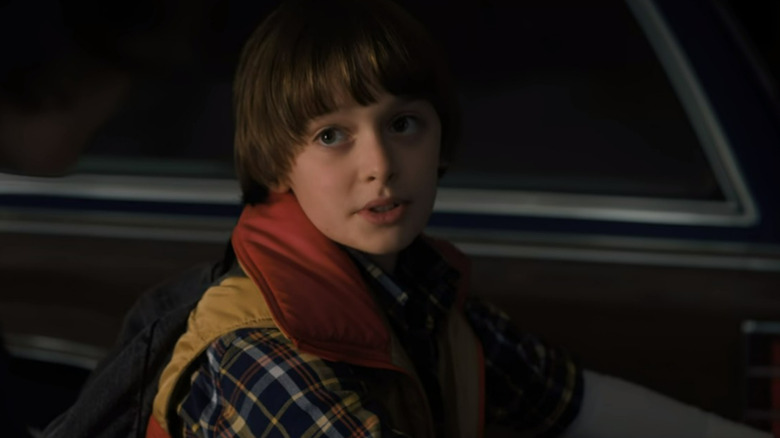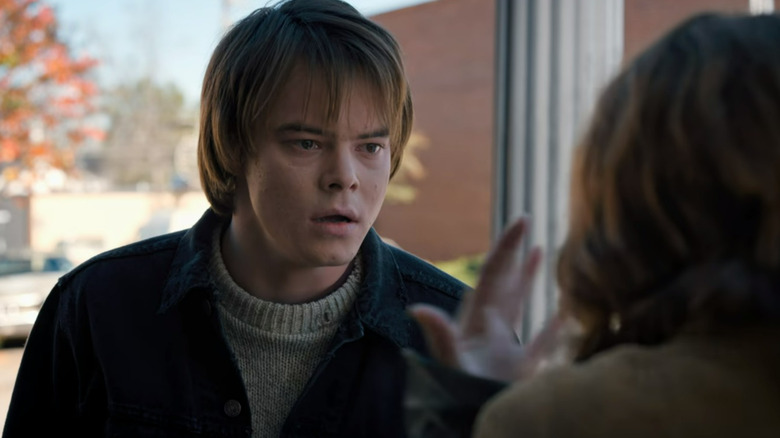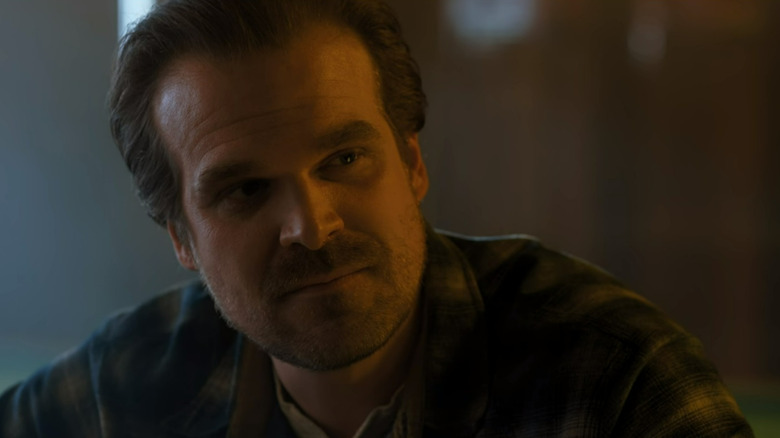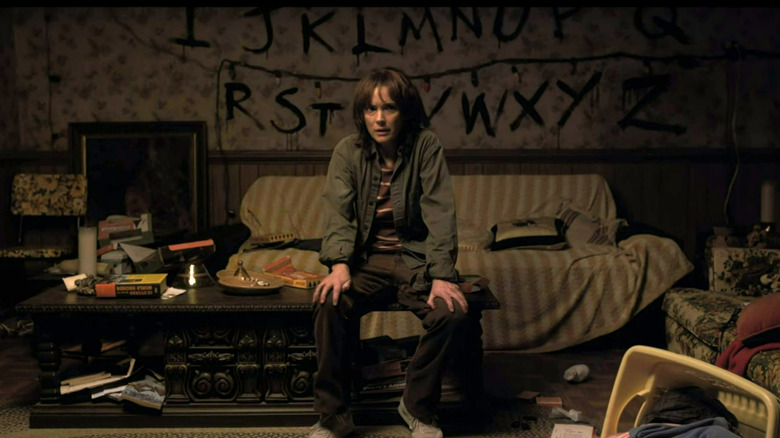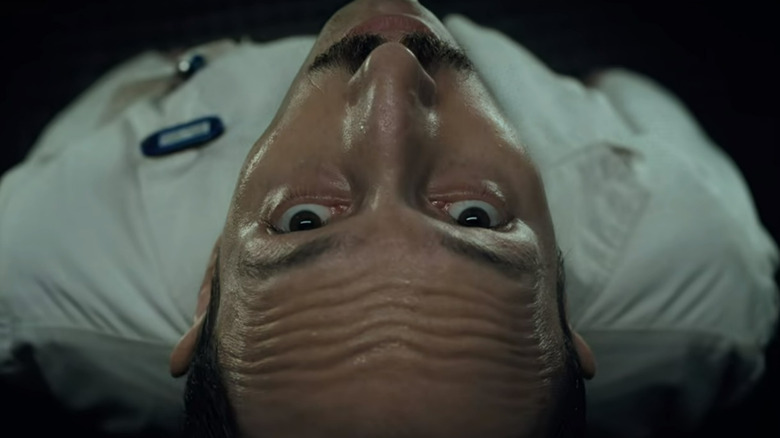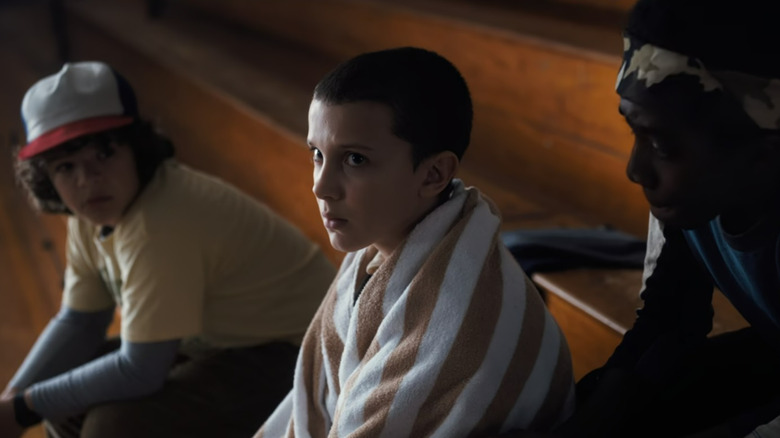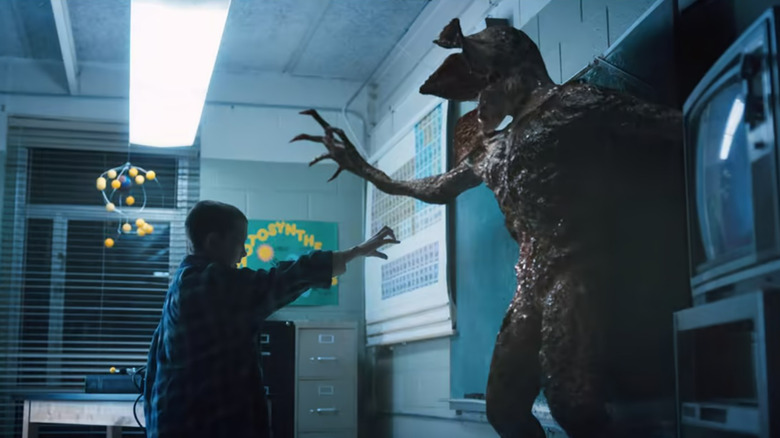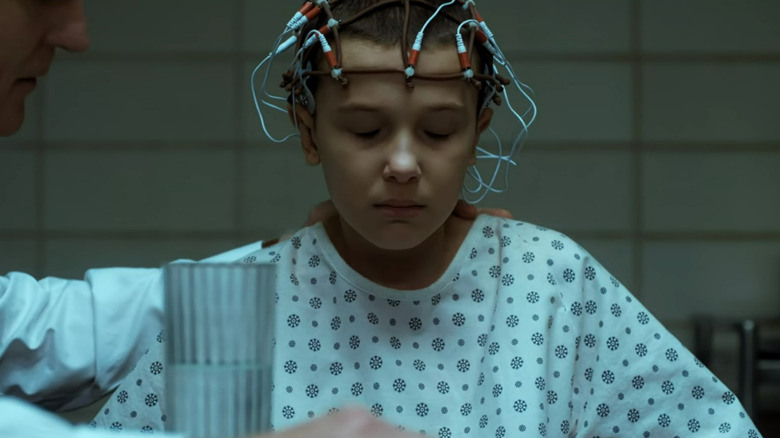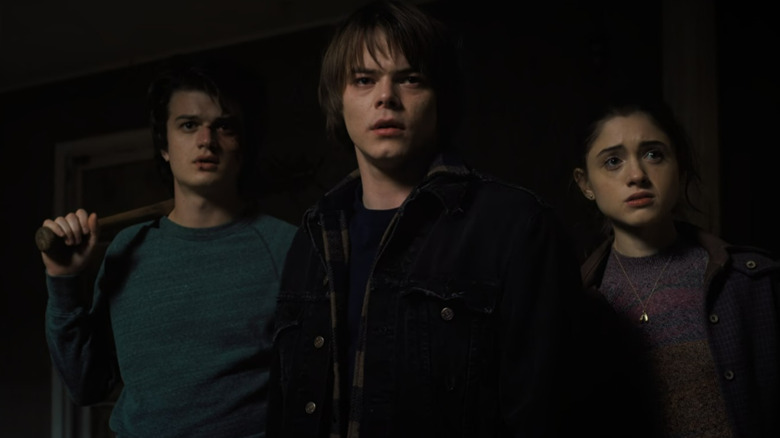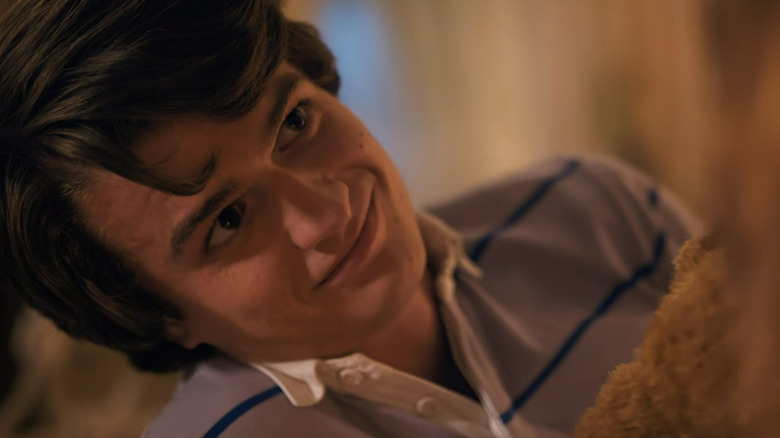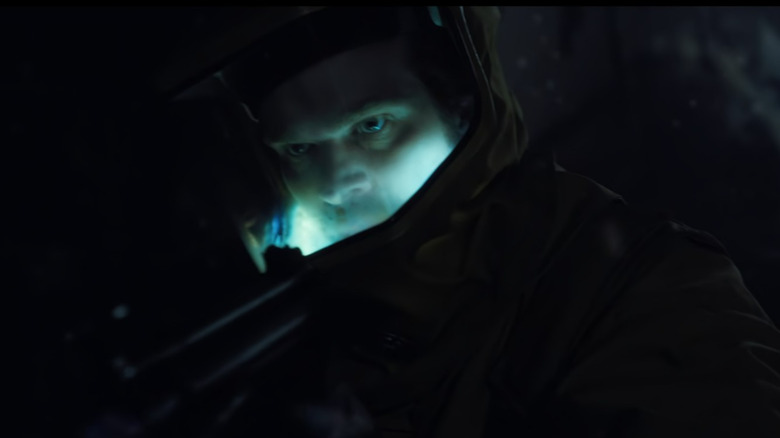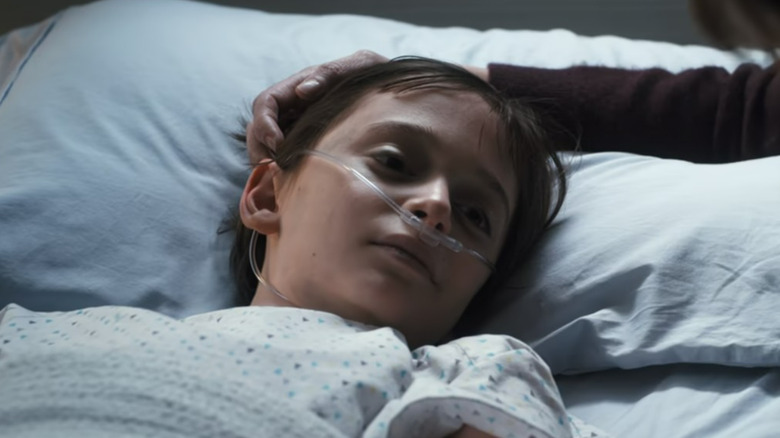Why Stranger Things Season 1 Is Still Its Best
It's no mystery that "Stranger Things" is one of the most popular TV shows of the streaming era. The Duffer brothers' retro sci-fi horror saga has repeatedly broken records at Netflix, assembling a massive fan base of dedicated viewers in the process. The combination of the show's '80s aesthetic, numerous old-school horror inspirations, and stellar ensemble cast has proven to be a winning formula season after season.
And yet one season still stands head and shoulders above the rest.
When "Stranger Things" Season 1 premiered in the summer of 2016, it was a revelation. Despite the hit that it quickly became, rumors have circulated for years that Netflix didn't have much faith in the series at the start and therefore held back on extensively promoting it (per Us Weekly). Whatever the underlying reasons, "Stranger Things" was certainly a bit of a stealth release, but that may have ultimately worked to the show's benefit. The first trailer only gave hints of the kind of story audiences would be in for, which imbued the whole viewing experience with a unique sense of discovery.
Of course, that kind of sneaky success would never belong to "Stranger Things" again. The show quickly exploded in popularity, and it's been a juggernaut ever since. And yet, despite the acclaim that later seasons have earned, there's something undeniably distinct about the show's first chapter. Here's why "Stranger Things" Season 1 is still its best by far.
A tight focus
Over the years, "Stranger Things" has progressively grown bigger in its narrative scope, nearing "Game of Thrones" numbers in terms of its characters and plotlines. Each season brings new additions to the cast, who in turn bring their own respective arcs and twists to the main story. "Stranger Things" Season 1 still had a sizable cast in its own right, but the overall narrative focus was much tighter, which ultimately led to a lot of its success.
There are really three main character groups in "Stranger Things" Season 1: Will's friends, who (with Eleven's help) try to figure out how to save him despite their parents' wishes; the teenagers, mostly consisting of Nancy, Steve, Jonathan, and Barb; and the adults, only two of whom really matter (Joyce and Hopper). For the most part, this structure holds true throughout the show — a cast broken up by age, with three main groups represented.
But in "Stranger Things" Season 1, all these different characters and groupings revolve around the same storyline — finding Will. Eleven's powers and origins are explored as a part of Will's disappearance, as is the nature of the Upside Down. Hopper's the sheriff, so of course he's involved in the investigation. And as Will's family, Joyce and Jonathan have a stronger connection to the plot than anyone else. This singular focus on Will allows the show to throw otherwise unrelated characters into wild situations together, and it also provides a method of exposition that's never clunky or forced.
Family first
It's hard to remember now, as nearly everyone who's featured on "Stranger Things" has become a star, but before Season 1 premiered on Netflix, Winona Ryder was the only real bankable name attached to the series. It made sense, then, that the story of Season 1 largely revolves around Joyce. At its core, it's a show about a mother looking for her son.
Over time, Joyce's manic zaniness has become just one part of the show's personality, but it meant a lot more in Season 1. She wasn't just a weirdo, she was the weirdo — the single mother who Hawkins residents looked at with equal amounts of pity and scorn. Of course she'd think her son, most likely dead, was talking to her through the Christmas lights. She's losing it, after all. Poor thing. The brilliance of her arc in Season 1 is that she's right. She's not just easy to root for because she's a loving mother, but because it's exciting to see her be vindicated. Joyce's arc in Season 1 is an incredible underdog story. In the rest of the show, it's just a good story.
Similar praise is due Jonathan's arc in "Stranger Things" Season 1. In a genre where characters like him are usually written as either rebellious or overly sad, he strikes a difficult balance. Is his life harder because of his family situation? Yes. But he doesn't resent his mother or his little brother for it. He's a boy who wants desperately, more than anything, to be a man — not because of his teenage ego or to impress some girl, but because it's what his family needs him to be.
Subverting expectations
At every turn, "Stranger Things" Season 1 pulls off the unexpected. It makes Eleven, a tiny, frail-looking girl, the most powerful character. It takes all the nerd knowledge of a group of kids and turns it into practical, useful data. Most impressively, it takes character archetypes from its '80s influences and transforms them into complex and nuanced people.
Hopper is probably the best example of this. His introductory scene paints him as the typical grizzled cop — a sour, lonely man struggling with untreated mental health problems and a number of different substances. This image is further detailed by his curt response to Joyce's (admittedly outlandish) claims. But then, halfway through Episode 4, something shifts. He begins questioning the man who supposedly found Will's body, and when he doesn't get the answers he wants, he turns to more violent methods. In the blink of an eye, Hopper goes from a washed-up sheriff to the most capable action hero on the planet, and because David Harbour sells it all so well, you never doubt his abilities for an instant.
A similar twist befalls Steve Harrington later in "Stranger Things" Season 1. Despite his clear persona as the shallow cool kid (and a bit of a bully to boot), he makes a decision to be better — to call his friends out on their lousy behavior and stand for something. With these character subversions, "Stranger Things" shows that it's never beholden to your expectations, and that every character who gets screen time is a fully fleshed-out person. Once you get past Season 1, though, those kinds of surprises are much harder to pull off.
Novelty in style
This one's pretty obvious, but it still merits discussion. Today, it's not at all uncommon to see a movie or show employ some heavy 1980s music or aesthetics, but that's a trend that was encouraged by the success of "Stranger Things." In 2016, the cassette tapes and synthwave beats weren't nearly as mainstream, yet the show made them work flawlessly in Season 1. Whether it's the Clash's "Should I Stay or Should I Go" being used as Will's bittersweet theme song or New Order's "Elegia" playing over a montage of people preparing for his funeral, the musical choices are perfect and drive the mood home every time.
The same goes for all the other stylistic touches — the corridor shots and monster scenes that harken back to old John Carpenter movies, the Steven Spielberg influences lurking around every corner, the attention to detail on era-appropriate costumes and props; the list goes on and on. Of course, all of the "Stranger Things" style still plays in the later seasons, and the creators continue to find fun ways to incorporate details from the '80s. But it's impossible for the aesthetic impact not to diminish with time. There are still standout musical moments in later seasons, like Max's Kate Bush escape in "Stranger Things 4," but they're still just moments. In Season 1, every shot is like a treasure hunt — an invitation to explore the richness of the show's retro originality.
Making old things new
"Stranger Things" has never been subtle in its influences. In fact, it wears them on its sleeve. The horror of the Demogorgon is a blend of "Jaws" and "The Thing." The mystery men from Hawkins Lab harken back to Spielberg's "E.T." The list of references and allusions to sci-fi and horror classics is long enough to fill its own article, and it only gets longer as you go through the later seasons. And yet it works.
In later seasons, the laundry list of '80s influences can begin to feel tiresome, especially as the show ventures outside the sci-fi and horror realms. At times, later arcs can seem like montages desperately trying to evoke some sense of nostalgia. Remember "Red Dawn"? Remember "Home Alone"? Remember "Dawn of the Dead"? Remember "The Terminator"? Remember "Nightmare on Elm Street"? At their best, the later seasons of "Stranger Things" still wield their inspirations with deftness and skill, but at their worst, they can feel like an allergy test of stories you've already seen.
Season 1 has no such problems. It seamlessly blends its (still obvious) influences together in such a way that it all manages to feel fresh. In short, it's the definition of something being greater than the sum of its parts.
The characters' ages really mean something
Because producing TV seasons takes a long time, and because puberty often doesn't, the younger stars of "Stranger Things" quickly outpaced their characters in terms of age. That's not inherently a problem — especially because they're all so fun to watch, regardless of age — but in combination with the larger narrative arc of the show, it has the unfortunate effect of making every character feel kind of the same.
Take "Stranger Things 4," for instance. Joyce, Dustin, and Steve Harrington are all widely different in age, and yet they occupy similar roles in the story. They all know the same things — about the Upside Down, about Hawkins Lab, about Eleven's powers, etc. — and they're all therefore willing to believe the same things. Steve's looking for love, and so is Joyce. They all take part in the action of the story, and they all more or less look like adults.
Compare that to Season 1, where the ages of characters really mean something. Mike, Lucas, and Dustin are the only ones besides Joyce who really believe that something strange is going on because they're kids. They live in a world of science fiction and fantasy, which ends up giving them an edge when dealing with things that most rational adults wouldn't believe. Steve isn't a cool guy — he's a nervous teenager with cringey flirting skills. And Jonathan doesn't believe his mom because he thinks he has to be an adult, and adults don't follow flights of fancy. Characters behave according to their age, but they all still have something to contribute. That's a powerful dynamic that's unfortunately lost once everyone starts looking and behaving the same way.
The Demogorgon is scarier than the Mind Flayer
Let's talk about something super specific that makes "Stranger Things" Season 1 great — the Demogorgon. It's the perfect monster in the closet; a beast of immense power and unknown origin that can appear and disappear again instantaneously. The Duffers have been open about how big of an influence "Jaws" was on the monster, and that influence works extremely well. The constant threat of the Demogorgon permeates every moment of Season 1, imbuing even the most mild of scenes with a level of underlying tension.
While monsters in later seasons certainly get bigger, they don't necessarily get better. "Stranger Things" builds out a ton of lore for the Upside Down between the Mind Flayer, Vecna, and all the other, smaller monsters that appear throughout the show. But the more the writers reveal, the less terrifying it all ends up being. The Demogorgon works because so little is known about it, and because it seems — at least for the most part — unkillable. Eleven's duel with the Mind Flayer at the end of Season 2 and the battle of Starcourt Mall are great moments, to be sure, but do they actually achieve greater tension than Steve's baseball bat battle in Season 1? It's subjective, of course, but sometimes less is just more.
Eleven
Every villain needs a hero, and Eleven rises as that paragon in the battle against the Demogorgon. Millie Bobby Brown's performance as El has always been a highlight of "Stranger Things," and she has a lot of great moments throughout the whole show. However, her arc in Season 1 is still arguably her best.
A big part of what makes Eleven so great in Season 1 is that everything about her is a surprise. You don't know what she's capable of until she does it, and even after using her powers for a specific purpose, it's hard to predict what her limits are. There's also a particular kind of surprise in seeing such a young actor pulling off such challenging emotional material. Is it fun to see Eleven doing cool stuff as a teenager? Absolutely. But it doesn't have quite the same effect as watching a literal child fight monsters, kill bad guys, and toss bullies around like rag dolls.
There's a reason that Eggos saw a huge boost in sales upon the release of "Stranger Things" Season 1 (per CNN). It's not just because Eleven's love of the frozen snack is endearing, it's because it's so memorable. The sci-fi genre has seen hundreds of teenage superheroes and unwitting test subjects, but it had never seen anyone quite like El before — at least not the version of El who stars in Season 1.
Narrative parallelism
Because "Stranger Things" Season 1 has such a tight narrative focus, it's also able to work in a lot of parallel storylines and thematically linked character arcs. Will and Eleven are a great example of this. They're both young characters who've been suddenly and violently thrust out of their homes and are forced to survive in a landscape that's dangerous and strange to them. The idea of a normal boy being thrown into a supernatural place and a supernatural girl being thrown into a (relatively) normal place is inherently interesting, and the parallels between Will and El — arguably the two most central characters — helps connect the different sides of the story.
The ever-evolving relationship web consisting of Jonathan, Nancy, and Steve also benefits from this kind of intentional writing. Jonathan's a teenager whose whole life is his family, Steve's a teen who doesn't have a great relationship with his family but is popular among his peers, and Nancy is caught somewhere in the middle, torn between a family she doesn't quite get along with and a "cool kid" culture that she doesn't fully agree with. This added layer makes the love triangle more than just a love triangle. You're made to care about each character individually, which makes the romantic drama even more engaging.
There are other examples of this too, like how Joyce's fear of losing a child triggers Hopper's trauma from losing his own. Everything feels intentionally placed with the rest of the story in mind, resulting in a clockwork seasonal arc that's tight and compelling the whole way through.
Funny but not goofy
There's a lot of humor in "Stranger Things" Season 1. From the kids' wacky science teacher and the boys' group dynamic to nearly everything Steve Harrington does, the writers pepper in plenty of moments to lighten the mood and embrace the campier elements of the show's '80s influences.
Make no mistake, though: "Stranger Things" Season 1 isn't a comedy. Will's absence and the mystery surrounding it permeate every shot, maintaining a thick sense of drama and tension no matter what jokes might be getting made onscreen. The humor serves to augment the real story, creating a world that never feels too dark, but which also never stops feeling serious. There are no goofy divergences in the season's climax, nor any moments when the focus on a joke distracts from the real plot. Unfortunately, that isn't something that can be said for the later seasons of "Stranger Things."
Make no mistake, there are some absolutely golden moments of comedy in the series' later installments. Eleven's flamboyant dumping of Mike early in Season 3 is a great example. But there are also a lot of instances of the show being too goofy. Do we really need a ham radio singalong in the middle of the Season 3 climax — an episode in which major characters die and the fate of the world is on the line? Do we need a whole "Home Alone" homage at Suzie's house in Season 4 while teenagers are being killed in their dreams a few states over? Again, levity is a good thing, as long as it doesn't create complete tonal dissonance. In Season 1, "Stranger Things" understands that perfectly.
A real sense of mystery
Perhaps the biggest difference between the first season of "Stranger Things" and those that follow is that at the beginning, no one — including the audience — knows what's going on. The Upside Down is a complete mystery. The Demogorgon is terrifying because its powers aren't fully explained. The whole story is an enigma, from the nature of Hawkins Lab and the origins of El's powers to the level of danger the Upside Down actually presents. Remember when people had to put on giant suits to even go through the gates because they were afraid the atmosphere of Upside Down could be deadly?
Inevitably, mystery in a science fiction story can't last. You have to explain things, and the more you explain, the less intrigue there is. By the time the story hits Season 3 and Season 4, there's very little left unknown. We all understand what Eleven is capable of, what the Mind Flayer wants, the scope of its power, and what the members of Hawkins Lab were doing. It's not a knock against the later seasons of "Stranger Things" that they sacrifice mystery in order to further the plot, but it is a fact. There's something really special about the stories you can tell when the audience is in the dark, and "Stranger Things" Season 1 thrives on that potential.
Stranger Things Season 1 is a complete story
When is a sequel necessary? We could sit around all day and debate. In the realm of modern television, where seasons are often left with big unanswered questions in the hopes that more episodes will be ordered, it's even more complicated. When you have a cast and a writing team as strong as those in "Stranger Things," it makes total sense to keep pushing forward. But that doesn't change the fact that the show's first season is a complete and wonderful story on its own terms.
Yes, Eleven's survival is left up in the air, and Will clearly isn't fully free of the Upside Down by the time credits roll on Episode 8. But the major storylines of the show up unto that point are satisfyingly wrapped up. The Byers family is reunited. Steve learns a lesson. Hopper finds a new lease on life. The kids are all forced to grow up a little bit. There's plenty left to explore — Nancy and Jonathan's relationship, Eleven's future, the exact nature of the Upside Down — and the successive seasons do a lot of great things with that material. But none of those plotlines are the main story of "Stranger Things" — at least not in Season 1.
The first eight episodes of "Stranger Things" are about family. They're about what might happen if that person you think is crazy was actually on to something. And they're about how everyone, no matter their age, has something valuable to contribute. The episodes that follow are about all kinds of things — young love, old love, demons, monsters, superheroes, trauma, friendship, adolescence — and that's great. "Stranger Things" becomes an ensemble show whose real draw is seeing how each character continues to grow season to season. But in becoming that show, it also loses a lot about what made Season 1 so very, very special.
